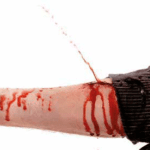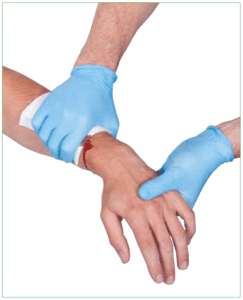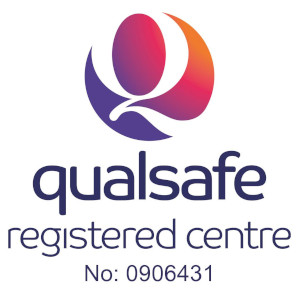Have you ever cut yourself and created a severe bleeding injury?
Continue to read our blog to find out the bleeds that can cause shock and our top tips to STOP a severe bleeding injury.
Thousands of people are killed or seriously injured in accidents each year in the UK. If first aid was administered prior to the arrival of emergency personnel, many deaths could be avoided.
Do you work in construction, manufacturing, or on a building site? This is where you are at a high risk of having a severe bleeding injury. If so, these areas are the most common to have a severe bleeding injury. There are many precautions you can carry out to prevent having a severe bleeding injury. Ultimately you NEED to wear your PPE – personal, protective, wear if you work in construction, manufacturing or on a building site. Your PPE will help minimize the severity of having a severe bleeding injury. Not only your PPE, following your health and safety procedures and risk assessments will reduce the injury.

How to Treat a Severe Bleeding Injury? Our Top Tips!
First, it is important to stop and manage the severe bleeding injury as soon as you can. There are three types of bleed you could have. These are; Arterial bleed – where it will spurt. Venous bleed – where it will ooze. Capillary bleed – where it will trickle. The first two bleeds – arterial and venous, are the worst bleed you could possibly have. You can loose a lot of blood in a short amount of time and it is hard to stop these severe bleeding injuries. Having a capillary bleed is the most common bleed you could have. This bleed, it will be able to blood clot and will be the easiest to stop with applying pressure.
Steps to take:
- Sit or Lay the casualty down.
- Examine the wound! You are looking to see if there is an embedded object, where the exact point the bleed is bleeding from and the type of bleed. (If there is an embedded object – LEAVE IT IN!)
- Apply pressure, until the bleeding injury has stopped, we aim to apply pressure for 10 minutes.
- Apply a bandage. If the bleed comes through, remove the saturated bandage. Continue with point 3, apply a new sterile bandage.

When a considerable amount of blood or fluid is lost, the body goes into hypovolemic shock, which causes it to start shutting down. Haemorrhagic shock is the term used to describe hypovolemic shock brought on by blood loss.
Heavy bleeding injuries can cause people to have haemorrhagic shock
Your organs and tissues receive oxygen and other necessary nutrients from the blood. These compounds are lost after severe bleeding more quickly than they can be replenished. The organs in your body start to shut down when there is insufficient blood flow to them.
Shock symptoms develop as your heart stops beating and is unable to pump enough blood through your body. A severe drop in body temperature with a sharp reduction in blood pressure can be fatal.
The bleed can’t stop! There will be a lot of blood being lost, shock may be present. If your casualty is cold and clammy, grey looking skin, with blue tinges to the face and lips, they are showing signs of shock. You will need to know when it is time to refer them to hospital. To treat for shock, you need to lay your casualty down, and raise their feet by 12 inches. It is time to take them to hospital or call 999.
What is an Arterial Bleed?
The most deadly type of bleeding is arterial bleeding, often known as pulsatile bleeding. Major injuries are usually what trigger it.
Since arterial blood originates from the heart, it is red and oxygenated. Additionally, it will rhythmically shoot out with each heartbeat. Blood can squirt up to several feet in a burst under this pressure.
Arterial haemorrhage is more challenging to manage than venous bleeding. Each heartbeat’s force disrupts the blood clotting cycle, which can result in significant blood loss.
Venous bleeding
Venous bleeding occurs when a vein is torn or cut. The blood will look dark red and ooze out of the body, moving steadily and slowly. It won’t shoot out like arterial blood. Although venous bleeding looks different, it can be just as serious as arterial bleeding.
It’s important to stop the bleeding as soon as possible by applying firm pressure on the wound.
If the bleeding doesn’t stop after a few minutes, the person becomes pale or unconscious or blood pressure drops, call 999. You should also get emergency help if the wound is very deep or if the person shows signs of shock.
Capillary bleeding
The most typical type of bleeding is capillary bleeding. It occurs with all wounds since it occurs whenever the skin is damaged. It doesn’t cause as much harm as other types of bleeding.
Blood from capillaries leaks or drips from the body. It also moves swiftly, although it is typically simple to manage. Capillaries are tiny, and the majority of injuries that produce capillary bleeding are minor.
Sometimes blood can become trapped under the skin if the capillaries rupture as a result of a physical assault. A bruise results from this.
What to do for a minor bleed?
If someone is injured, you should:
- first check that you and the injured person aren’t in any danger, and, if possible, make the situation safe
- if necessary, dial 999 for an ambulance when it’s safe to do so
- carry out basic first aid; apply pressure and apply a bandage
If someone is unconscious and breathing
If someone is unconscious but breathing, and has no other injuries that would stop them being moved, place them in the recovery position until help arrives.
Keep them under observation to ensure they continue to breathe normally.
What should I do if the wound dressing gets wet due to bleeding?
Recently the guidance has changed with regards to applying a wound dressing. It was taught to apply up to three bandages then remove and start over again. In July 2021, the Resuscitation Council has updated the treatment of wound dressing. Once pressure has been applied – ‘you may need to press into the wound’, you will need to apply a dressing. If a dressing gets saturated with blood, take it off and make sure you are applying direct pressure to the exact point of bleeding. Only re-dress it when the bleeding is controlled.
For more information about the Resuscitation Updates
How to treat a wound with an embedded object
Do not remove the embedded object from the wound. If the embedded object is removed it can cause an arterial bleed. It may also be stemming any bleeding.
- Use two wound dressings either side of the embedded object. If the wound is bleeding you can apply pressure either side of the object.
- If there is glass in the wound they will need an x-ray to ensure that all shards are removed
- If the object is a splinter, that is not deeply embedded in the wound and you can clearly see and grasp the end. Use sterile tweezers to pull it out in the reverse direction that it went in. Clean and dress the wound if necessary.
When is bleeding an emergency?
In most cases, bleeding is minor and can be stopped with first aid care.
However, bleeding can be a medical emergency, even if the bleeding has stopped. You should get emergency help in the following scenarios (additional emergency scenarios may apply):
- the bleeding doesn’t stop after several minutes of applying pressure
- the bleeding spurts out quickly, which is a sign of arterial bleeding
- the wound is deep, large, or embedded with an object
- the wound exposes the bone
- the wound involves the eyes or abdomen
- the wound is in the chest or neck and causes difficulty breathing
- the injury was caused by a motor vehicle accident
- the person shows signs of shock
Calling 999
When calling 999, when a catastrophic bleed is present they will ask you; “how much blood can you see?” It can be easily said “a lot”.
Blood can go everywhere; in clothing, bandages, with environment – furniture, and on the floor. It can be very hard to see how much blood has been lost. As a tip, on our courses we explain how spilling a glass of water or a pint of beer can look a lot on the floor. Be a very expensive night out if it was a pint of beer spilt. We need to recognise if we can see a pint, half a pint a standard glass of blood on the floor. We need to recognise how many bandages have been used. These bandages need to be contained in a separate bag and will be took to the hospital with the casualty. And finally, we are there to recognise if there is and how much blood is in the casualties clothing.
Bleeding Supplies
At HMB Training we can provide bleeding supplies for your first aid kit. Without buying a full bleeding first aid kit, which can cost a lot of money, we can help provide individual items. Tourniquets are proven to help save lives. If they are used correctly and applied at the right time before shock sets in, a tourniquet will prevent a casualty losing their third loss of blood and prevent death.
The life-saving equipment needed in the event of a catastrophic bleed can be obtained by enrolling in a first aid course that includes actual, hands-on instruction in the use of a tourniquet.
To purchase your tourniquet from our shop – Click here to purchase a tourniquet
Further Training
We offer a range of first aid courses for all ages from workplaces to education. On our emergency first aid courses we can teach more in-depth about catastrophic bleeding. Furthermore, we can create bespoke first aid courses including catastrophic bleeding as the main topic for your session
Our current first aid courses;
- Emergency First Aid at Work
- First Aid at Work
- Emergency Paediatric – one day
- Paediatric – two day
- Parents’ first aid – 2-3 hours
- Children’s first aid – 2 hours – ages 8 plus
Our Emergency and First Aid at Work courses are for those working in an office, factory, warehouse, manufacturing or on a building site. These courses will set you up to know exactly what to do in an emergency. Completing our courses will help you understand the hazards and risks in your workplace to therefore prevent accidents.
Apprentices, staff who are unlikely to be left alone with children, and lunchtime supervisors are all candidates for our Emergency Paediatric First Aid Training. Our one-day course includes roles and responsibilities of a first aider, first aid kits, accident reporting, reasons of a life-threatening condition, CPR, defibrillator, causes of unconsciousness and recovery position, choking, bleeding, burns, and minor injuries.
Our Paediatric First Aid Training 2-day course includes all elements of the one-day first course including; broken bones, spinal injuries, head injuries, slings, sprains and strains, diabetes, febrile convulsions, hypothermia, hyperthermia, epilepsy, poisons, eye injuries, allergies and anaphylaxis, and asthma.
This course is ideal for those working alone with children, whether you are a Teacher or Teaching Assistant working in the Early Years or a childminder. Our Paediatric courses are fully accredited. We have open courses running at our Brownhills Centre or we can come to your setting.
Additionally, if you prefer to have a short session with us and complete a bespoke parents/grandparents course; our Parent’s first aid course is for you. These start from 2 hours up to 4 hours. Can include any modules of your choice, but we will cover: reasons of life-threatening conditions, CPR, Defibrillator, unconsciousness, recovery, choking and gagging, burns, and minor illnesses, including dangers within the home.
Our courses provide you with the peace of mind that you’ll know what to do in the event of an emergency, such as illnesses like asthma. Furthermore, getting first aid training will give you the skill set of knowing exactly what to do if your child, friend, or work colleague suffers from an injury or life threatening condition. Never put yourself in a situation where you’re thinking, “What if I knew what to do?” Get First Aid Trained Today!
If you have any questions with this blog we are happy to help. It is important to know what to do in an emergency if you have a severe bleeding injury. If you want to know how, our Emergency First Aid at Work Course, is the course for you. Here is the link to our upcoming courses. https://www.hmbtrainingservices.co.uk/courses
For further enquires please call us on: 01543 453338 or email on info@hmbtrainingservices.co.uk



